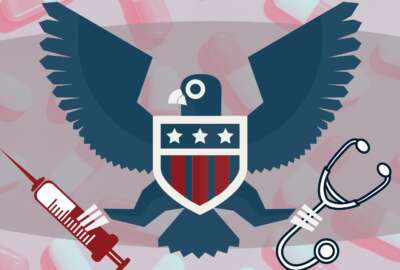Open Season Exchange 2023: OPM’s Kiran Ahuja on new FEHB coverage available next year
Whatever the reason, and whether or not you end up making a change at the end, the Office of Personnel Management encourages all FEHB enrollees to take a look...
Just like going to the doctor for a physical exam each year, federal employees and annuitants in the Federal Employees Health Benefits Program would be wise to schedule an annual checkup on their health insurance options too.
There are many different reasons feds might want to consider a change to their plan options for 2024. Maybe they’re looking to expand their families or their overall health has changed. Or maybe they’re simply looking for a way to save a bit of money.
Whatever the reason — and whether or not someone makes a change in the end — everyone should take a look during Open Season at what will be changing next year, advised Kiran Ahuja, director of the Office of Personnel Management.
“Listen, I was one of these federal employees [who said], ‘I’m pretty good. I’m just going to let my plan roll over,’ ” Ahuja said during Federal News Network’s 2024 Open Season Exchange. “But we really are encouraging our folks to be proactive. There’s just lots of information that we want folks to take advantage of so we can increase the participation of going through the review. If your plan is great, that’s good. But we want to see more activity on our website to make sure that folks are taking advantage of those materials.”
The changes in health care needs aren’t just on the side of the individual enrollee though. OPM also announced major changes to the offerings available in FEHB and several new requirements of FEHB carriers this year. It’s all the more reason to read the information available on OPM’s website and in FEHB plan brochures, Ahuja said.
“Plans change. There are adjustments every year. There are certain things that we’re asking plans to cover. It’s just worth going back and saying, ‘Does this plan work for me?’ ” she said. “Maybe there is a significant life event or an addition to the family or other circumstances. Even if not, I just really want to encourage our federal employees to go through the exercise of taking a look at their current plan and actually see what’s now available because there are shifts every year.”
She encouraged employees and federal retirees to evaluate FEHB’s 2024 plans and coverage options using OPM’s plan comparison tool. Enrollees have until Dec. 11 to make health, dental and vision plan selections for the coming year.
FEHB changes coming in 2024
Some of those shifts for 2024 are quite significant and cover changes to fertility benefits, Medicare coordination, pharmacy benefit design, gender affirming care and services, maternal health, prevention and treatment of obesity, mental health and substance use disorders, telehealth, and antibiotic stewardship, OPM said in its Open Season guidance for 2024.
7.7%
Average premium increase for FEHB enrollees in 2024
SOURCE: Office of Personnel Management
Specifically, when it comes to infertility treatments, OPM for 2024 requires all FEHB carriers to cover at least two forms of artificial insemination and the drugs associated with those procedures, as well as at least three cycles of drugs related to in-vitro fertilization (IVF) annually.
In the area of maternal health, OPM said it’s looking to address inequities and calling on carriers to make improvements, for example, by providing information and raising awareness of potentially life-threatening warning signs during and after pregnancy. Many carriers will also offer coverage for support services, such as doulas.
Additionally, about 400,000 service members will get access to dependent care flexible spending accounts in 2024. A DCFSA lets an enrollee make pre-tax contributions for certain dependent care services, such as preschool, summer day camp, before- or after-school programs and child or adult daycare.
Many FEHB carriers will also begin offering expanded coverage for anti-obesity medications, low- or no-cost telehealth options for mental health and substance use disorder services, and expanded gender-affirming care for transgender and gender-diverse individuals.
Recent OPM survey data on federal benefits showed that many early-career individuals are attracted to government work because of these expanding options.
“We know that federal employees under the age of 40 do very much appreciate the benefits and also the leave that we provide as part of the federal government,” Ahuja said. “These types of benefits make a difference for federal employees and make a difference around the retention that we want in the federal government.”
Hedging against rising FEHB premium rates
Along with increasing coverage in several health care areas, federal employees and annuitants will see insurance premium rates rising alongside that.
For 2024, FEHB enrollees will pay an average of 7.7% more toward their health care premiums.
Next year’s premium increase comes after an 8.7% jump for 2023. Given a few consecutive years of rising premium rates, some enrollees might be getting anxious.
“Our team works very hard to find the right balance between providing the comprehensive coverage that our federal employees and their families have learned to expect and appreciate, coupled with the affordability of those plans,” Ahuja said. “That is something we constantly strive for in the balance that we see. Our barometer is, where is the industry trend? This time around, in 2024, we do fall slightly below that trend with similarly situated or sized employers.”
By comparison, CalPERS, which purchases health insurance for California state government employees, announced even higher premium rate increases for 2024, at an average of 10.77%. CalPERS is the nation’s second-largest public insurance purchaser, only after the federal government.
Additionally, it’s important to remember that not every FEHB carrier has increased its premium rates for the coming year. It’s all the more reason that OPM is encouraging enrollees to take a look at their options during Open Season and evaluate the balance between premium rates and the coverage they will need.
Aside from switching plans, there are ways that FEHB enrollees can find cost savings too. Setting up a flexible spending account through OPM’s FSAFEDS program can help offset some of those growing costs. An FSA lets an enrollee set aside pre-tax dollars to go toward certain out-of-pocket health care expenses.
Despite the opportunities available through FSAFEDS, just 20% of federal employees are currently enrolled in the program.
“I keep on getting shocked by the numbers,” Ahuja said. “You can take advantage of the FSAFEDS for some of those out-of-pocket expenses.”
Participants can also carry over up to $500 into another health care FSA in the subsequent year.
Dental and vision changes
Similar to FEHB, Ahuja said she recommends taking a look at dental and vision options, too. Compared with a 7.7% average increase in FEHB premiums for 2024, the vision and dental premiums are rising much less. Premiums will grow for dental plans by 1.4% on average, while vision plans will go up by 1.1%.
“We know that the premium increases for the dental and vision plans tend to be a lot more modest than the health plans,” Ahuja said. “So that’s something for folks to think about as they determine whether it’s a good deal for their family to take advantage of those particular plans.”
FEHB enrollees can compare 2024 plans by using OPM’s plan comparison tool.
To discover more insights and advice shared during the 2024 Open Season Exchange, visit the event page.
Copyright © 2025 Federal News Network. All rights reserved. This website is not intended for users located within the European Economic Area.
Drew Friedman is a workforce, pay and benefits reporter for Federal News Network.
Follow @dfriedmanWFED
Related Stories
Featured speakers
-

Kiran Ahuja
Director, Office of Personnel Management
-

Drew Friedman
Reporter, Federal News Network
Upcoming Events
Related Stories
Top Stories

Kiran Ahuja
Director, Office of Personnel Management

Drew Friedman
Reporter, Federal News Network
Drew Friedman is Federal News Network’s reporter covering workforce, pay and benefits. She previously worked as a producer for the program Government Matters at WJLA-TV, covering the business of the federal government. Drew graduated from the University of Virginia in 2018 with a B.A. in media studies.





